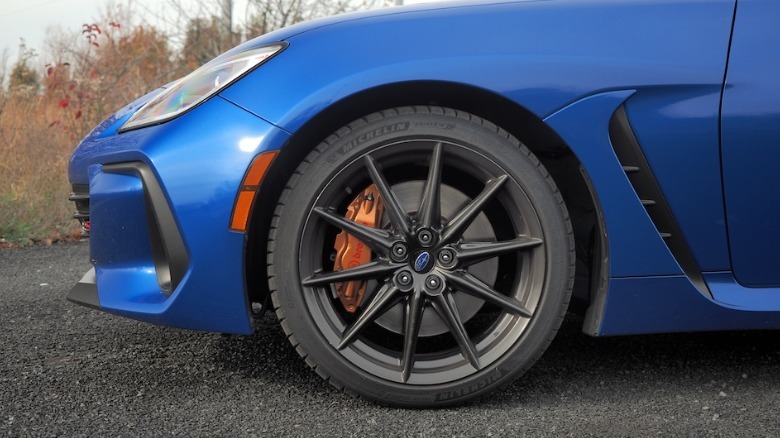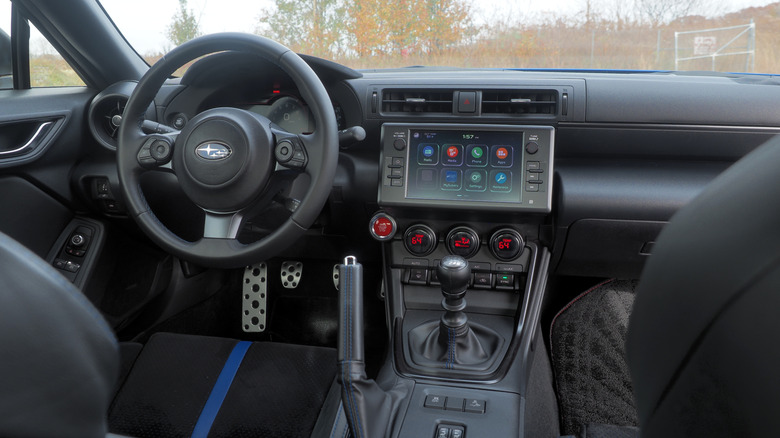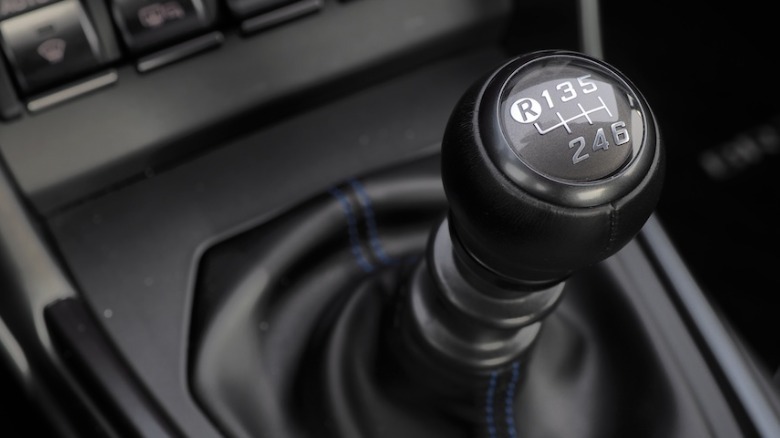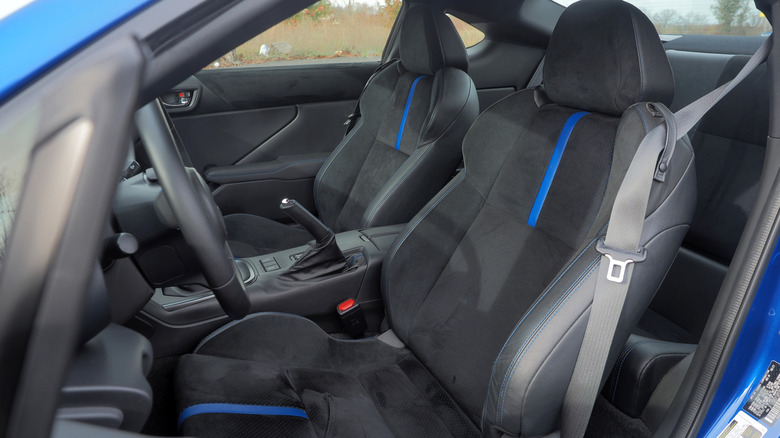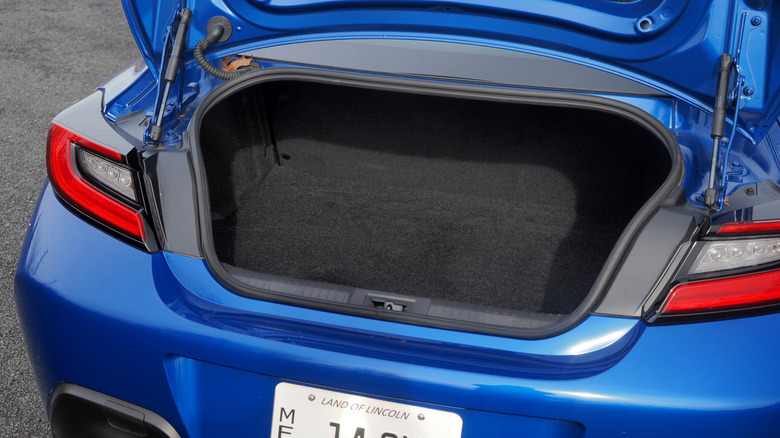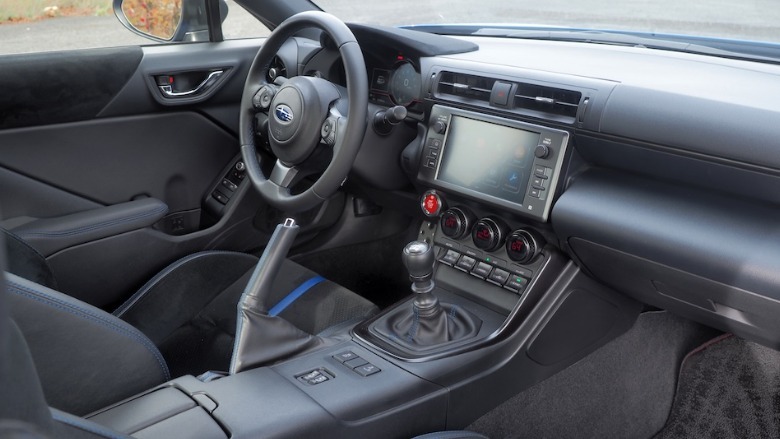2025 Subaru BRZ tS Review: Great, But Not The One You Should Buy
- Affordable fun
- Feisty engine begs to be wrung out
- Cabin and trunk are reasonably sized (for the segment)
- Infotainment system is mediocre
- Cabin feels cheap in places
- Rear seats could be considered punishment
Like arch rivals teaming up in a Marvel movie to fight the universe's true threat, these days it's hard to imagine the Subaru BRZ and the Mazda MX-5 Miata being the nemeses they were once positioned as when the BRZ debuted all the way back in 2012. Then, the Subaru coupe — and its Toyota GT86 (née Scion FR-S) sibling — were seen as a direct response to the stalwart Miata. A showdown, rather than a show of support, for a segment that always seemed on fairly shaky ground.
Today, if there's a rivalry, it's in the same way that competitive neighbors might jokingly trash-talk each other's lawnmowers. A recognition that a rising tide lifts all ships, particularly in a niche segment like attainable two-door cars for enthusiasts.
For the new model year, Subaru doesn't mess too much with a working formula. The 2025 BRZ keeps its naturally aspirated engine and its rear-wheel drive; it sticks with the original strategy of affordability over toys, along with a nod to blank slate potential for those with customization and mods in mind. However, it also brings a top-spec BRZ tS trim to the party.
Three trims with minor differences
Subaru offers three trims on the BRZ, from the base Premium (from $31,095), through the Limited (from $33,745), to the BRZ tS (from $36,245; all prices before $1,170 destination). All get the same engine, a 2.4-liter boxer flat-four with 228 horsepower and 184 lb-ft of torque. A six-speed manual is standard; if you want Subaru's 6-speed automatic, it's an $850 option but only offered on the Limited trim.
The other distinctions between the Premium and Limited trims are mainly aesthetic and comfort focused. All BRZ get the Torsen limited-slip differential; the Limited adds nicer 18-inch wheels shod in Michelin Pilot Sport 4 rubber, heated front seats, and a cabin trimmed in leather and faux-suede with red contrast stitching. Either way, there's still the same seven exterior color options, and a predominantly black interior.
The 2025 BRZ tS, however, shakes things up. It has custom, STI-tuned suspension, and Brembo brakes — with 4-piston front and dual-piston rear fixed calipers, plus larger ventilated rotors — behind the 18-inch dark gray metallic-finish wheels. Inside, there are blue accents and a custom, STI-design cluster UI.
The tS is stiffer, but no more powerful, and that's fine
While some might question Subaru's thinking in not giving the BRZ tS some extra power, on balance it seems like the right strategy. Unlike in the realm of supercars and sports sedans, where "more" inevitably means "better," the charm of cars like the BRZ — see, again, Mazda's MX-5 Miata — is in how they make you work for your glee.
I'd make the same argument in favor of the manual transmission, if Subaru even offered the automatic on the BRZ tS. It doesn't, though, making life easier.
Traditionally, while the Subaru and its Toyota GR86 sibling are closely related, the BRZ has generally been acknowledged as being tuned with a little more focus on comfort. It's a slight distinction, certainly — I suspect you'd need both cars side by side, and probably a track, in order to coax out meaningful differences from behind the wheel — but the tS trim should go some way to addressing concerns that Subaru "dialed back" its coupe.
A basic cabin doesn't stress the budget
Inside the snug cabin — officially a four-seater, though accommodations in the rear will test even the dimensions of small children — Subaru makes tackling the worthy challenge of dragging every ounce of fun from the BRZ as straightforward as possible. The steering wheel is small, but not too small; the stubby stick shift is notchy in all the best ways. There's a touchscreen, but all the climate control and driving settings are handled through big buttons and knobs.
Were I a cynical sort of person, I might point out that Subaru's focus here is probably just as much the result of cost savings as it is intentionally keeping things simple for the driver. The chunky buttons, manual parking brake, and generally pared-back design — not to mention an infotainment system that feels like a dropped-in afterthought — all smack of minimizing development costs and making maximum use of existing parts bins.
The result doesn't exactly feel premium everywhere your fingers might roam — the leather-wrapped steering wheel is nice, for instance, but the stalks behind it feel cheap — but, on balance, I concur with Subaru's priorities.
Wring it out, reap the rewards
That's because the BRZ tS is fun. Lots of fun. Actually, any flavor of BRZ is, predominantly because you're actively encouraged to wring the heck out of it. Peak torque from the naturally aspirated engine arrives at 3,700 rpm, tantalizingly within reach.
For leisurely driving — you could, if kid-free, live with the BRZ as your daily — there's enough to the low-end to zip around town or casually overtake without having to shift down a gear. At the same time, though, the clutch is pleasantly light, making notching up and down the ratios a zero-headache affair. The only thing which would improve matters would be auto brake-hold, though the clutch is easy enough to modulate to hold yourself at a stop sign or traffic signal.
Locate a more entertaining stretch of road, meanwhile, and foot-to-the-floor driving is a must. There's no sense, as in more potent cars, that you're not making the most of all the power you paid for: you're incentivized to max out your right foot's contribution.
A great car for learning to hoon in
With a 2,851 pound curb weight (for the tS version), sticky tires, and sharp, direct steering, flinging the BRZ around corners is a joy. It's not the fastest, no, but it's communicative and responsive: there's a real sense of the speed and grip remaining, making it easy to nudge closer to the limit (and recover if you get a little over-excited).
You can turn the traction control off, or switch the BRZ into Track Mode. That dials back the electronic safety tech — though not entirely — allowing the rear end to slip and wag more than might ordinarily be the case. Beyond that, though, there are no "drive modes" in the usual sense: if you want sharper gearshifts, that's down to your right hand and left foot.
Honestly, if your goal is to become a better driver, a car like the BRZ tS would be a great route to take. Unlike cars with double its horsepower, you can't rely on brute force alone to rescue you from, say, a poor gear decision. On the flip side, get things just right, and you need not share the credit with anybody else (well, maybe Subaru's engineers and STI tuners).
It's usable as a daily-driver, just about
The rest of the BRZ experience is either forgettable or focused, depending on you charmed you are by its driving dynamics. The infotainment does what it promises to, though the audio system won't exactly wow your ears, and the 8-inch touchscreen washes out easily from brighter sunlight. Those diminutive rear seats are best considered overflow for the 6.3 cu-ft trunk. Sure, it's not as snug as a Miata's, but that's because Mazda's rear storage is ridiculously small.
Adaptive cruise control, pre-collision brake assistance, and lane departure warnings and assistance are standard across all trims. Blind spot warnings with lane-change assist and rear cross-traffic alerts are standard on the Limited and tS. There's no getting away from the reality that the BRZ can feel disconcertingly dinky when surrounded by trucks.
Then there's the fuel economy, which isn't as small as the Subaru itself. Officially, the EPA rates the manual BRZ at 20 mpg in the city, 27 mpg on the highway, and 22 mpg combined (the automatic lands at 25 mpg combined). Expect real-world numbers to come in lower, assuming you're making the most of your toy.
2025 Subaru BRZ tS Verdict
At one point, not all that long ago, the very concept of affordable, fun, and approachable cars seemed like it might be on the way out. Despite those fears, there's actually a surprisingly broad array of models, now, catering to enthusiasts. And, while the BRZ (and GR86) along with the Miata may be one form of such a car, they're by no means the only option.
Toyota's GR Corolla starts at $39k, though for that, you get usable back seats and all-wheel drive; a Hyundai Elantra N (from $34k) is far more comparable in price with the Subaru, comes with a manual transmission as standard, and is genuinely good fun without sacrificing practicality. Or, there's the Civic Si, starting at $30k, with its nearly-as-good-as-a-Type-R stick paired with Honda reliability.
Swell as the BRZ tS is, there's something to be said for the Subaru in its cheapest, base form. Without the fancier brakes, or the slightly firmer suspension tuning, or even the distraction of nicer seat upholstery and a handful more cabin toys. It's charming in its simplicity: any further sparkle required, you're expected to supply yourself from the driver's seat.



